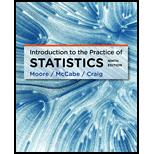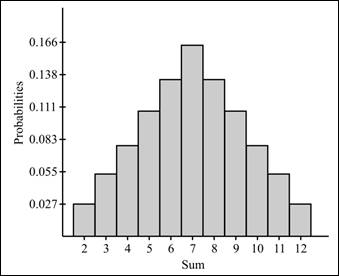
Concept explainers
(a)
All 36 pairs of up-faces.
(a)
Answer to Problem 55E
Solution: All possible pairs are:
Explanation of Solution
(b)
The probability of each pair.
(b)
Answer to Problem 55E
Solution: The probability of each pair is
Explanation of Solution
Probability for pair (1, 1) is:
Probability of (1, 2) is:
Now, it can be continued for remaining outcomes. Hence, the probability of each pair is
(c)
To find: The values of X and give the probability distribution of X. and drawing a probability histogram.
(c)
Answer to Problem 55E
Solution: In this study, sum of up faces is defined as X. The probability distribution is:
Explanation of Solution
Graph: The histogram for the above probability distribution is provided below:

(d)
The probability of rolling 7 or an 11.
(d)
Answer to Problem 55E
Solution: The probability is 0.221.
Explanation of Solution
Hence, the probability that 7 or 11 comes up on the next roll of two dice is 0.221.
(e)
The probability that any other sum except a 7 is rolled.
(e)
Answer to Problem 55E
Solution: The probability is 0.834.
Explanation of Solution
Hence, the probability is 0.834.
Want to see more full solutions like this?
Chapter 4 Solutions
Introduction to the Practice of Statistics
 MATLAB: An Introduction with ApplicationsStatisticsISBN:9781119256830Author:Amos GilatPublisher:John Wiley & Sons Inc
MATLAB: An Introduction with ApplicationsStatisticsISBN:9781119256830Author:Amos GilatPublisher:John Wiley & Sons Inc Probability and Statistics for Engineering and th...StatisticsISBN:9781305251809Author:Jay L. DevorePublisher:Cengage Learning
Probability and Statistics for Engineering and th...StatisticsISBN:9781305251809Author:Jay L. DevorePublisher:Cengage Learning Statistics for The Behavioral Sciences (MindTap C...StatisticsISBN:9781305504912Author:Frederick J Gravetter, Larry B. WallnauPublisher:Cengage Learning
Statistics for The Behavioral Sciences (MindTap C...StatisticsISBN:9781305504912Author:Frederick J Gravetter, Larry B. WallnauPublisher:Cengage Learning Elementary Statistics: Picturing the World (7th E...StatisticsISBN:9780134683416Author:Ron Larson, Betsy FarberPublisher:PEARSON
Elementary Statistics: Picturing the World (7th E...StatisticsISBN:9780134683416Author:Ron Larson, Betsy FarberPublisher:PEARSON The Basic Practice of StatisticsStatisticsISBN:9781319042578Author:David S. Moore, William I. Notz, Michael A. FlignerPublisher:W. H. Freeman
The Basic Practice of StatisticsStatisticsISBN:9781319042578Author:David S. Moore, William I. Notz, Michael A. FlignerPublisher:W. H. Freeman Introduction to the Practice of StatisticsStatisticsISBN:9781319013387Author:David S. Moore, George P. McCabe, Bruce A. CraigPublisher:W. H. Freeman
Introduction to the Practice of StatisticsStatisticsISBN:9781319013387Author:David S. Moore, George P. McCabe, Bruce A. CraigPublisher:W. H. Freeman





